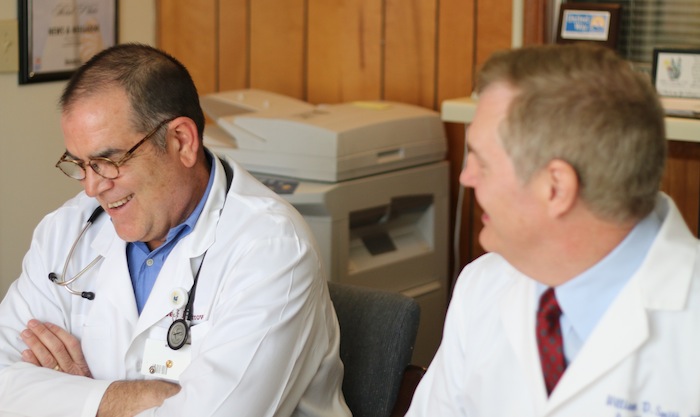By Jeff Keeling
When he spoke at the Wellmont Health System-Mountain States Health Alliance merger announcement April 2, Dr. Jeff Farrow was effusive in his praise of the proposed deal’s benefits for physicians. Farrow, a pulmonologist and Mountain States board member, said a combined system could, “help us attract the best and brightest physicians to our region.” He added that a goal for the combined system would be, “to become one of the most fulfilling places in the country to practice medicine” and to be “one of the nation’s best providers of care.”
That said, Farrow acknowledged, “there will be smart, thoughtful questions about the proposed merger, especially from physicians, nurses and other clinical professionals.” Farrow and a Wellmont colleague, board member and anesthesiologist Dr. Bill Smith, sat down with the Business Journal April 22 to discuss the proposal from a physician perspective – albeit that of system board members. Their bottom line? The Affordable Care Act, and health care reform in general, are changing the landscape so rapidly that many traditional concerns about issues such as anti-competitive situations, doctors losing independence to giant hospital systems and others are rapidly losing relevance. Additionally, Farrow and Smith said, the greater Tri-Cities has specific challenges that can better be addressed by a combined system, and specific opportunities that can better be capitalized on, particularly with East Tennessee State University’s health sciences programs more formally in the mix.
Business Journal: Wthis might turn out to be should it be successful, is really a sea change in clinical approach, clinical practice. (Wellmont board member Nelson) Dr. Gwaltney talked about “our ability to impact the patient not in the hospital but in their home.” If I’m a specialist, or in one of the areas that is directly more inpatient and acute care-related, and I hear that, I might think, it sounds like there’s some obvious pros to population health, some obvious reasons to do this, but from a personal perspective, I’m like, ‘ok, what gives here – what can I expect?’”
Jeff Farrow: With the Affordable Care Act and the emphasis on population health it’s not a Northeast Tennessee issue, it’s a national issue. It’s basically us responding to being told what health care is going to look like in the next 10 years, towards the end of mine and Dr. Smith’s practice. Those of us who are specialists … know that we have to be part of that system, and it can’t go forward without those individuals as well. Change begets concern; it should, and hopefully it begets a thoughtful approach to sorting out what’s the best way to deliver health care in the future, which is going to change. It’s going to change for (Smith) and I, who have been in practice for 25-plus years. What we do day-to-day is going to change some, and we have to be ready to do that. Whereas for Bill, like me, it’s always been about productivity, because it was fee for service, see as many patients as you can see responsibly and effectively, it’s going to change. It’s going to be managing groups of individuals to better care for those individuals, and we’re learning about that.
Bill Smith: To follow up on that, I think what the doctors that are talking to me are talking about the Affordable Care Act, but also about this just-passed (Medicare) sustainable growth fix, in which the federal government has said, ‘the way we’re going to reimburse physicians is going to change. We’re going to change the way we do it, and it’s not going to be based on volume, we’re going to base it on outcomes and on quality. So this is very timely, I think, for the specialists in this area in that we’re actually out ahead of that just a little bit. Everybody knows that this is changing. We’ve been hearing about this our whole career, that medicine’s going to change – well, I’m convinced it’s finally here. I’ve been waiting for it for almost 30 years, so this merger opportunity is kind of like an opportunity to be in on the ground floor. Not intentionally, but it’s turning out to be perfectly timed.
BJ: How much difference might having a single platform for electronic medical records make in the success of a merged system?
Farrow: One of the things that will be successful in a merger like this is the opportunity to share information. When an individual’s admitted to the ‘other’ hospital system, they have a discharge and it’s really hard to get that information. Sharing the information technology amongst a large system will streamline that for the primary care physician, who never saw that patient in the hospital. They have everything they need right there at their fingertips. They don’t have to, if they’re in the other system, try to track down an X-ray at Wellmont, that kind of thing. That’s a huge plus.
BJ: Is that something that today affects physicians at every level, including internists and primary care docs who may have more of a relationship with Mountain States but then their patient ends up going to a Wellmont hospital or vice versa, the amount of time it takes to get the information that you need?
Farrow: I suspect that if you surveyed the primary care physicians in the region who had access to both systems at their fingertips, it would be a really small number, yet they have patients who are in either. I hear that over and over again. Physicians struggle with that and need quicker access and better access to do the things we’re talking about for their patients.
Smith: Readmissions are a negative outcome of that. That’s a big thing. If you – an older you, a sicker you – gets admitted to the hospital, any hospital, and you get discharged, there’s not an automatic mechanism that your primary care doctor’s going to know about that. Your primary care doctor would want to follow up pretty quickly after a hospitalization to check on you, to make sure that we’re doing everything we can to keep you on an outpatient basis. When the systems are separated like they are now, that’s not guaranteed. With the systems separated, readmissions could occur more often, and the penalty’s going to occur. (Medicare imposes financial penalties for what it deems higher-than-recommended readmission rates.) There’s more financial risk. The government is rightfully pushing us in a direction of, ‘we’ve got to do better.’
BJ: Has either of you had any colleagues, friends, during the course of this process pull you aside or say, ‘hey, can we sit down for awhile, I want to talk to you,’ who were very concerned, and were you able to dialogue with them and bring them to a comfort level? What it is that’s working to convince the skeptical?
Smith: As I was driving here I got a call from my office that there was a physician in Bristol that wanted to talk to me. I called that individual on the speakerphone in the car and talked to that person as I was coming over here. They had some specific questions about what was going on and how the committees that are going to deal with this merger process are going to be populated. Not concerned so much as just interested – wanted to know, ‘what’s the thinking, how are we doing this?’
Farrow: I would steer you towards the idea of this integration council, which to me is probably as key as anything, maybe as key as the board makeup. The integration council, made up of individuals who have some expertise in population health, who have some expertise in the culture of this region having been here a long time, are going to be able to sit down and work out things that the average physician, including myself, have concerns about. I think anybody who sees this big change in the future is going to have some concerns. They should. It should make them think about what they need to do in their practice, what’s the best way to manage those patients in a new system that combines all of these hospitals – three large hospitals, basically. Whenever I speak to them I just refer them to the idea that much of the ideas that are going to implant are going to come out of that council.
BJ: Talking about the broad scope of clinicians who are obviously involved at every level of care, it really seems that the possibility is for a ramp up in job growth in non-physician care, and maybe in primary and internist type of care. Is that something you all see, and as doctors in the roles that you are in, how important is it that in a patient centered home or an ACO there be this growing array of people who are involved in keeping people healthy? That’s a lot different than ‘productive medicine.’
Farrow: I assume you’re meaning growth in advanced nurse practitioners, case managers, and if you think about it, that’s what the ACA’s designed to do is basically manage a population, sick or not. Individuals who only sought out medical therapy if they had a problem is a much different model than what we’re headed toward, so we need those individuals to manage that population.
BJ: When we talk about this region – sicker; poorer; poor health indicators and poor health habits – is it both exciting and a little daunting to think about this vision moving from where it is in early 2015 to where it could be in 2020 and 2025?
Smith: It’s not daunting. It’s a steep hill to climb, but it’s all upside. There’s no downside there.
BJ: With the traditional fee-for-service model going away, do you think most physicians find that appealing, since it is a matter of trying to keep people healthier instead of treat them when they’re sick?
Farrow: A lot of us who started out in practice who treated people once they were sick have realized how much more benefit it is, at least in my own personal practice, to address the issues before they get sick. Preventive medicine was what we used to call it. It’s got other names including population health and management. But I think those of us who have been in practice a long time are recognizing that if we can get things done on the front end – in my case smoking cessation – it makes a big difference long term for those individuals. Moreso than whatever I do for them in the hospital when they’re sick.
Smith: Teenage smoking is lower nationwide than it’s ever been, but what’s on the rise is vaping, which is something we don’t know enough about yet. So there’s going to be new and innovative problems that we’re going to have to solve. … So one of the real potentials of this merger is on the research side. This is a perfect incubator for a group of investigative physicians to undertake a look at the effects of vaping. So if we had the resources to do that, first off you’re going to attract doctors who want to do research. That’s an upside.
BJ: (ETSU President Brian) Dr. Noland has spoken to that, and that was spoken to in the runup to this when this merger was being advocated by some, as a large upside. What are the things, if the system comes into place, that are going to help attract the best and brightest and make this one of the most fulfilling places in the country to practice?
Smith: When we recruited two years ago, my group, we had an anesthesiologist we were trying to recruit who had done his cardiac fellowship at Mass General, and he had done his residency at Yale, and we were within an eyelash of getting him because this was the type of area that he and his wife wanted to move to to raise their family. But he had a research idea that he really, really wanted to pursue, and he’s at the Mayo in Jacksonville now. He’s been there three years. I saw him at a national meeting last week. We lost him – although he would openly say, they’ve got two kids now, one and one on the way – they’d rather be raising their kids here than in Jacksonville, Florida.
BJ: So if you could plunk down a more robust research environment, he might have…
Smith: He’d be giving anesthesia in Bristol today. So there’s a very concrete example of what we’re talking about.
Farrow: We’re excited about that possibility. There are just so many individuals that do, just like Bill said, want to live here, but they don’t have the ability to do what they do because it’s so specialized, without the support. That’s where ETSU becomes our partner if this occurs.
BJ: Was this something that either of you can honestly say you had thought would be a good thing if it could ever happen before the strategic process that Wellmont undertook began?
 Smith: I used to joke about this a long time ago, that that would be a good thing. The Wellmont board went through a strategic options process that I don’t think the Mountain States board did, so I come at this with a very different look, because I have this history of what all we went through to get here. And of all the options on the table, this is the only one that’s truly transformative. Everything else is transactional – this is transformative. We’re envisioning something new that is kind of out of the box. It’s really exciting.
Smith: I used to joke about this a long time ago, that that would be a good thing. The Wellmont board went through a strategic options process that I don’t think the Mountain States board did, so I come at this with a very different look, because I have this history of what all we went through to get here. And of all the options on the table, this is the only one that’s truly transformative. Everything else is transactional – this is transformative. We’re envisioning something new that is kind of out of the box. It’s really exciting.
BJ: Well, a health improvement organization – that struck me that day. I’d never heard of no health improvement organization, and so that’s not even a hospital system, at least in name, which connotes something transformative and different beyond a transactional arrangement. Yet what you all were talking about early in this conversation is, you look at the ACA, you look at percent of GDP spent on health care, you look at all those other things, and transformation is taking place nationally.
Smith: It’s going to happen. It has to. My daughter was a history major, and if you look back historically when the percentage of gross national product spent on any industry bumps up toward 20 percent, it’s going to fail. That’s what happened to the Soviet Union in military. You can’t put all your eggs in one basket – there’s too many other things a society needs. We need education, we need transportation, we need research, there’s a lot of stuff. You can’t give it all to health care.
BJ: Are you hearing any of your colleagues coming to you and actually talking excitedly and with a lot of hope? Understanding that, yeah, there’s a lot of variables and moving parts to this, but are some of the folks really catching this vision and getting extremely enthused about, ‘gee whiz, I can’t wait to see what this looks like in six years?’
Farrow: Yes, and I love hearing Bill’s perspective because I have been on the Mountain States board for a long time. I always dreamed that that would be an optimal way to practice within the region – to begin to look at how we manage our population and then deal with insurance companies, and Medicare and Medicaid as a whole, as opposed to still having to determine who we’re dealing with (as a patient base). So when it came to be, we began to look at the options, when we made our proposal to Wellmont it was clear to me that this wasn’t just the best choice for the region, it was the right choice for our region, and that we really needed to impress on them how eager we are to make this happen. I’m just so amazed at what’s happened with health care in our region after 25 years, and likewise colleagues feel the same way – never thought that that could possibly happen, but the opportunities, as we began to think about them, are huge, that we never really thought were possible before because of the way that the system was divided, pretty much down the middle.
BJ: Do you think one of the things physicians are excited about, whether they’re verbalizing it or not, would be those indicators that Randy Wykoff has hammered on every year, that maybe in a decade they can say, ‘here’s where those indicators went nationally, and here’s where our region’s went,’ and we look better?
Farrow: That’s what we’re working for, and this is the best way to do that. To do it in a concerted effort, with the focus being on the care of the individuals and the population, and not so much how you’re going to compete with a different service at your facility and those sorts of things that often were discussions before. Those will basically just disappear, because it’ll be, ‘what does the system do for our region and our community to make things better for them?’






